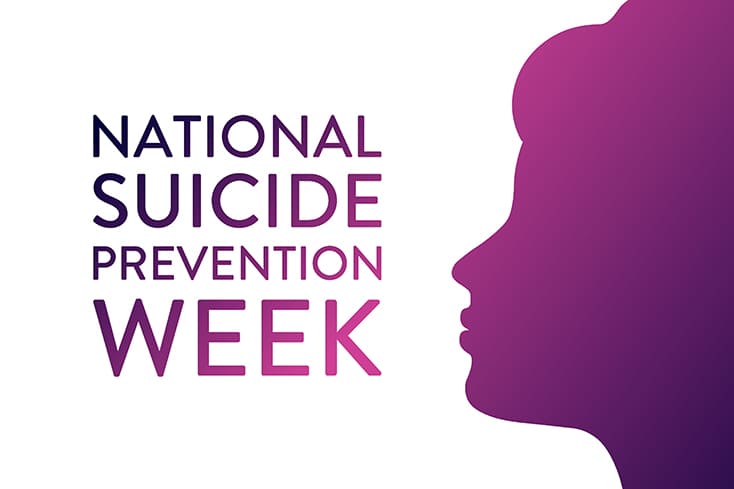September 09, 2020
By Katherine Ponte, JD, MBA, CPRP
If you or someone you know is experiencing a mental health, suicide or substance use crisis or emotional distress, reach out 24/7 to the 988 Suicide and Crisis Lifeline (formerly known as the National Suicide Prevention Lifeline) by dialing or texting 988 or using chat services at 988lifeline.org to connect to a trained crisis counselor. You can also get crisis text support via the Crisis Text Line by texting NAMI to 741741.

Suicide is a public health crisis.
Suicide rates rose 25% in the U.S. from 1999 to 2016. In 2018, nearly 50,000 people died by suicide, around 11 million seriously thought about it, about 3 million made a plan and over 1 million attempted suicide.
These numbers represent immeasurable tragic losses to human life, friends, family and society.
There is an urgent need to address the causes. Most suicide prevention programs focus on the now — the risk factors, which are essential. However, these programs should also focus on protective factors to have a longer lasting impact on those vulnerable to suicide.
Here are some of the primary risk factors for suicide, which may help us identify at-risk populations and individuals.
A combination of therapy and medication can help address some of these risk factors. But we also need to think about how we can protect the most vulnerable in other ways.
We often take a “reactive” approach to suicide risk. We identify risk factors and watch for warning signs. But sometimes, by the time warning signs are visible to others, it’s too late. An additional approach that may increase our impact is to identify protective factors that can help shield individuals from becoming at-risk in the first place.
Each person has their own “reasons for living” and recognizing them can be life-saving. The Reasons for Living Scale identifies possible protective factors for suicide, including meaningful relationships with friends and family, survival instincts, excitement about future plans, and the belief that happiness is an important part of life. These protective factors can not only reduce suicide risk, they can be good for general well-being and foster happiness.
During my extended periods of suicidal ideation in my struggles with bipolar, I would often reflect on my reasons for living. I felt that a suicide attempt or death would hurt my family too much, and I would not want them to suffer. I imagined the reactions of my spouse who had stuck by me. I imagined how my parents would take it after lovingly raising me and always being there for me. I imagined them heartbroken and filled with inconsolable grief and blaming themselves. I even thought of my cat, Dude, who never left my side in my darkest moments.
I also feared death. I’d hear examples of suicide in the news and it would heighten my own thoughts, but I ultimately couldn’t go through with it. I was scared of dying and knew deep down I wanted to live.
As I moved towards recovery, I discovered that I did have reasons for living and recovery itself gave me even more. My overwhelming pain and suffering, hopelessness and self-stigma had blinded me to these reasons and possibilities. I finally reached a point where I no longer thought of suicide, but instead recognized all the good in my life.
I realized that I had caring and loving social support, which I learned to accept. While this may not be for everyone, I also — very skeptically at first — learned to have greater faith in a higher power to “take care” of the things I could not control and help me in times of need. As my condition improved, my hope grew. Hope bolstered my belief that I had a future worth living, which I had to seize day-by-day. It would be a future supported by my friends and family.
We need to start coming together and speaking to each other more. We need to nurture and develop protective factors, especially among those closest to us. We need to stop missing opportunities to save lives through more caring and loving action among and between each other.
We can help prevent suicide, but we have to do it together. Suicide is not only an individual tragedy, it is a collective tragedy, our tragedy.
Suicide resources: National Suicide Prevention Lifeline1-800-273-8255 | American Foundation for Suicide Prevention | Crisis Text Line text HOME to 741741 (24/7) | The Trevor Project 866-488-7386 (24/7), Text START to 678678 | The Veterans Crisis Line 800-273-8255 and press 1 (24/7), Text 838255 (24/7) | Vets4Warriors | SAMHSA’s National Helpline (Substance Abuse) 800-662-HELP (4357) (24/7) | The National Alliance on Mental Illness | The Jed Foundation | Speaking of Suicide | Medscape | CDC Suicide Resources
Suicide education: LivingWorks Applied Suicide Intervention Skills Training (ASIST) | LivingWorks safeTALK | QPR Gatekeeper Training for Suicide Prevention
Katherine Ponte is a mental health advocate, writer and entrepreneur. She is the founder of ForLikeMinds, the first online peer-based support community dedicated to people living with or supporting someone with mental illness, and Bipolar Thriving, a recovery coaching service for caregivers and their loved ones affected by bipolar disorder. She is also the creator of the Psych Ward Greeting Cards program in which she personally shares her recovery experiences and distributes donated greeting cards to patients in psychiatric units. She is in recovery from severe bipolar I disorder with psychosis. She is also on the board of NAMI New York City.
We’re always accepting submissions to the NAMI Blog! We feature the latest research, stories of recovery, ways to end stigma and strategies for living well with mental illness. Most importantly: We feature your voices.
LEARN MORENAMI HelpLine is available M-F, 10 a.m. – 10 p.m. ET. Call 800-950-6264,
text “NAMI” to 62640, or email. In a crisis, call or text 988 (24/7).